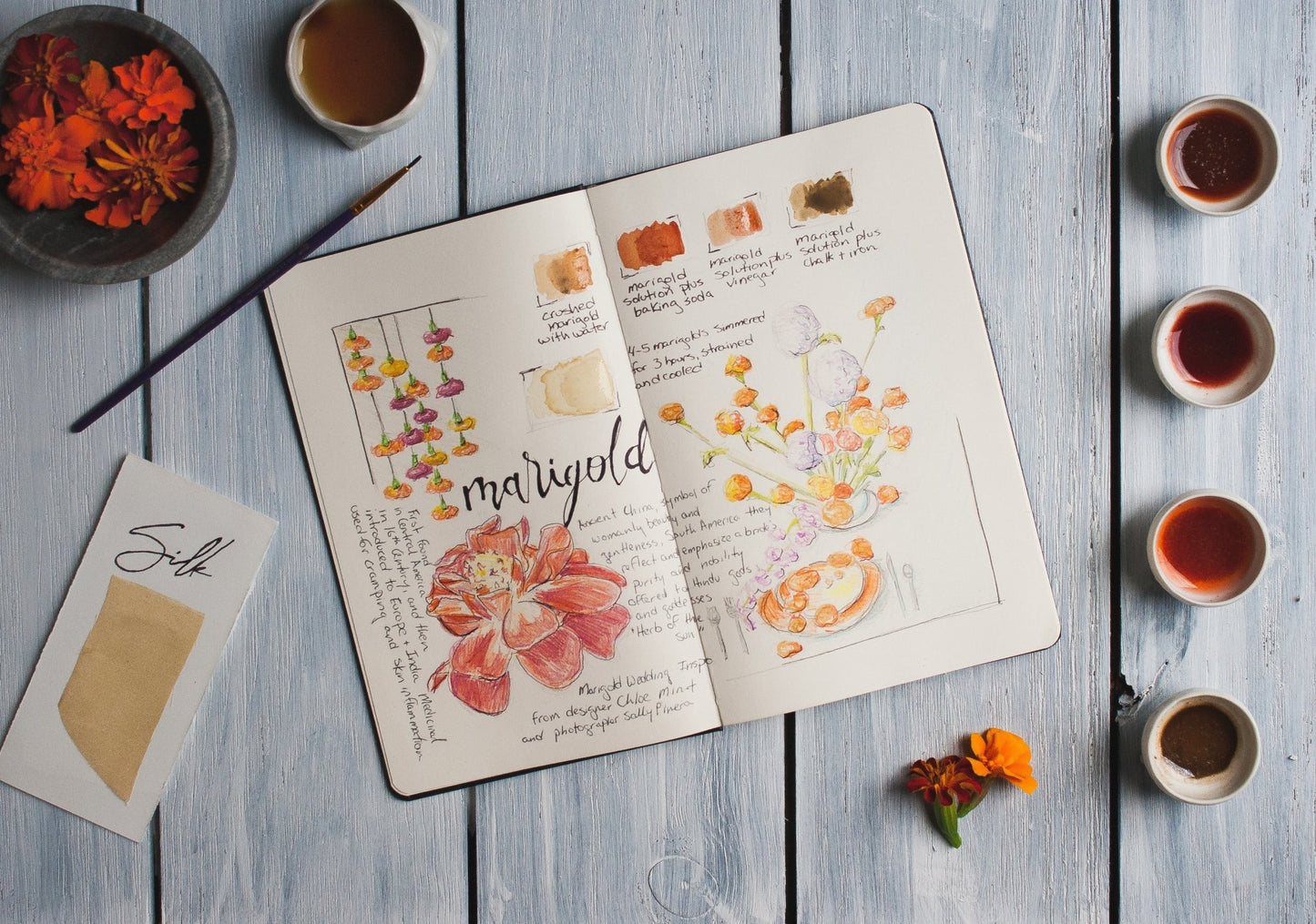
Pages from my dye journal with notes on plant dyeing, plant based paints, foraging and growing your own dye plants.
Natural Dye Journal
I have been working on this natural dye journal for a little over a year now. While I have kept a notebook, actually many many notebooks, of my dye tests, recipes and experiments, I thought that it might be nice to also keep a slightly more formal journal with thoughts about dyes, history, plant paint experiments and more.
Here are some of the entries that I have made so far. All of the plants and flowers illustrated in these pages are from seasonal experiments and include plants from my garden, those foraged in my neighborhood, or even grown on local flower farms. I hope you enjoy them.
Marigold

For the Marigold page I used marigolds from Sunny Meadows Flower Farm, here in Central Ohio. Marigolds make a lovely gold dye on mordanted silk, and I use them a lot in my ribbon and table linens.
For paint, I crushed the marigolds and used different additives like baking soda, vinegar and chalk and iron to shift the colors of the plant paint. I really loved the roses red achieved with the addition of baking soda, and the color has held up over time, which is a nice surpise. I have since made marigold pigments, which I turned into watercolor paints.
Watercolor paints from plants

Indigo

The second page that I made was for indigo. For my indigo trials, I used fresh indigo from my garden to make both the paint and the dye samples. I do use fermented indigo in my actual dye practice, but I do not grow that myself, as it takes a tremendous amount of time and effort to have enough to dye with.
Tango Cosmos

Next were the Tango Cosmos from my garden. These flowers were such a joy to grow. They were a joyful pop of color for the whole summer and I have fun harvesting blooms each day and drying them for later use. If you want to grow these yourself, I got the seeds for these from Grand Prismatic Seed.
Dyer's Coreopsis

Another joyful summer flower. For this journal page I used red and yellow coreopsis from Old Slate Farm and red and yellow blooms grown in my garden from seeds by Grand Prismatic.
Rudbeckia

While I was able to create a wide variety of colors using Rudbeckia Triloba that I foraged, Rudbeckia Hirta Sahara Cultivar and Triloba from Old Slate Farm and Rudbeckia hirta from Sunny Meadows. But I was not able to create the blue/greens and purples that I have seen other dyers achieve using these flowers.
I am left wondering whether soil pH, dye temps, etc. account for the differences and will definitely keep experimenting.
Pokeberry

I have been experimenting with Pokeberries for a while now. It is always a challenge to gather enough through foraging to get good colors. While I do love the pinks that you can get from Pokeberries, it is difficult plant to work with as the dye is sensitive to temperature and pH, which can cause the colors to shift. Also, please be careful using Pokeberries as they are toxic. Also, if you compost your spent dye materials, do not compost pokeberries, as you will find them in your garden from then on.
Scabiosa

I had a lot of fun experimenting with scabiosa grown in my garden with seeds from Grand Prismatic and larger blooms of Blackberry scabiosa which I got from a local floral wholesaler. I love the teal and the light pinks that I was able to create with the flowers.
Acorns

I use acorns as a base for a lot of my dyes, and you can always find me in the fall with pockets full of acorns. When combined with iron they can create a range of grays and blacks.
Pomegranate

Many people think that pomegranates give a red or pink dye. I have memories of eating pomegranates and thinking that the juice would stain everything. However, the juice from the pomegranate is actually a fugitive color. The part of the fruit used in dyeing with actually the rind. The rind makes yellows through khakis and greens depending on mordanting and modifiers.
Purple Corn

It is no surprise that purple corn creates a lovely purple color on silk. The color is brightened a bit with vinegar and becomes a steely grey with baking soda.
Purple Iris
For these trials I used purple bearded irises from my own garden, Dutch Irises and a near black bearded Iris from a local flower farm. I was happiest with the soft sea foam like greens from both bearded iris varieties.

